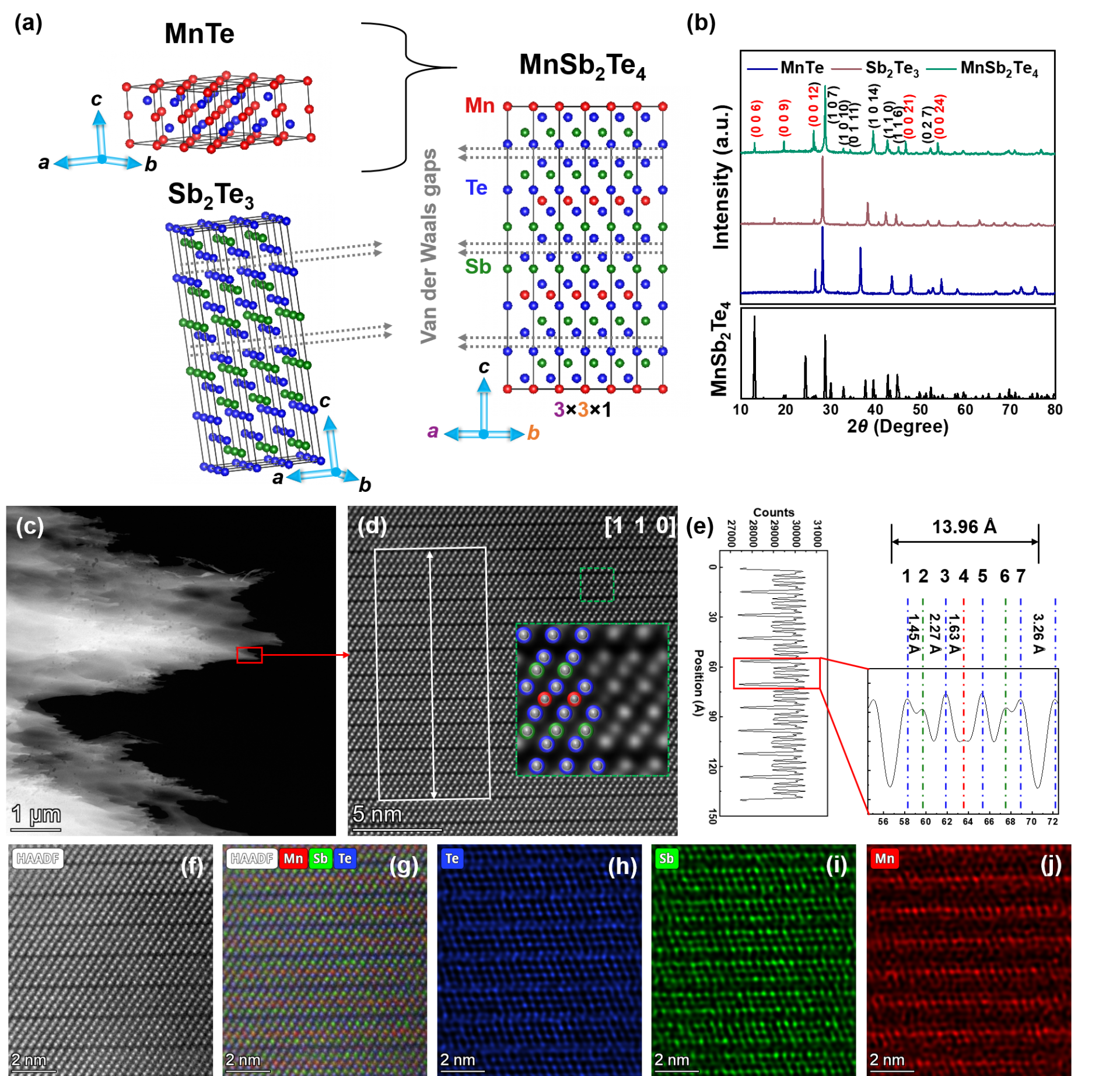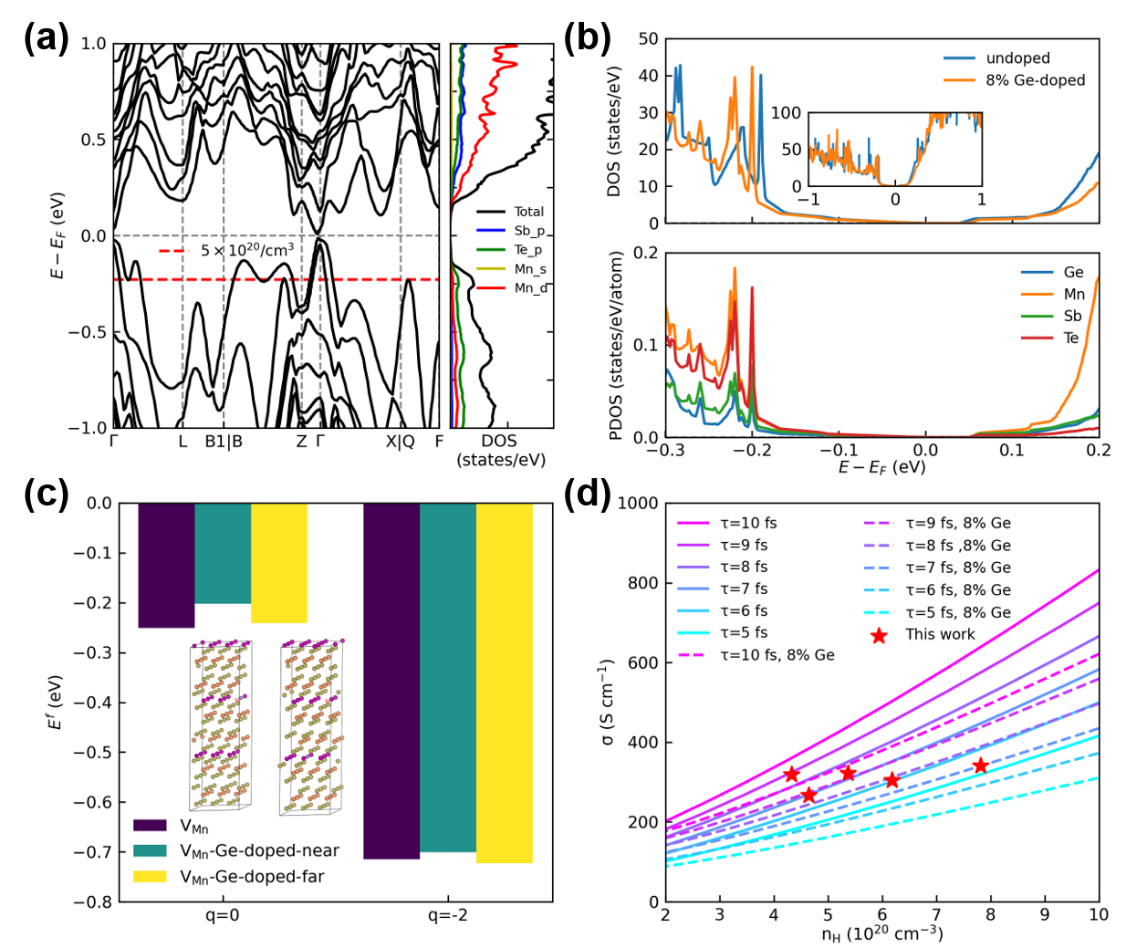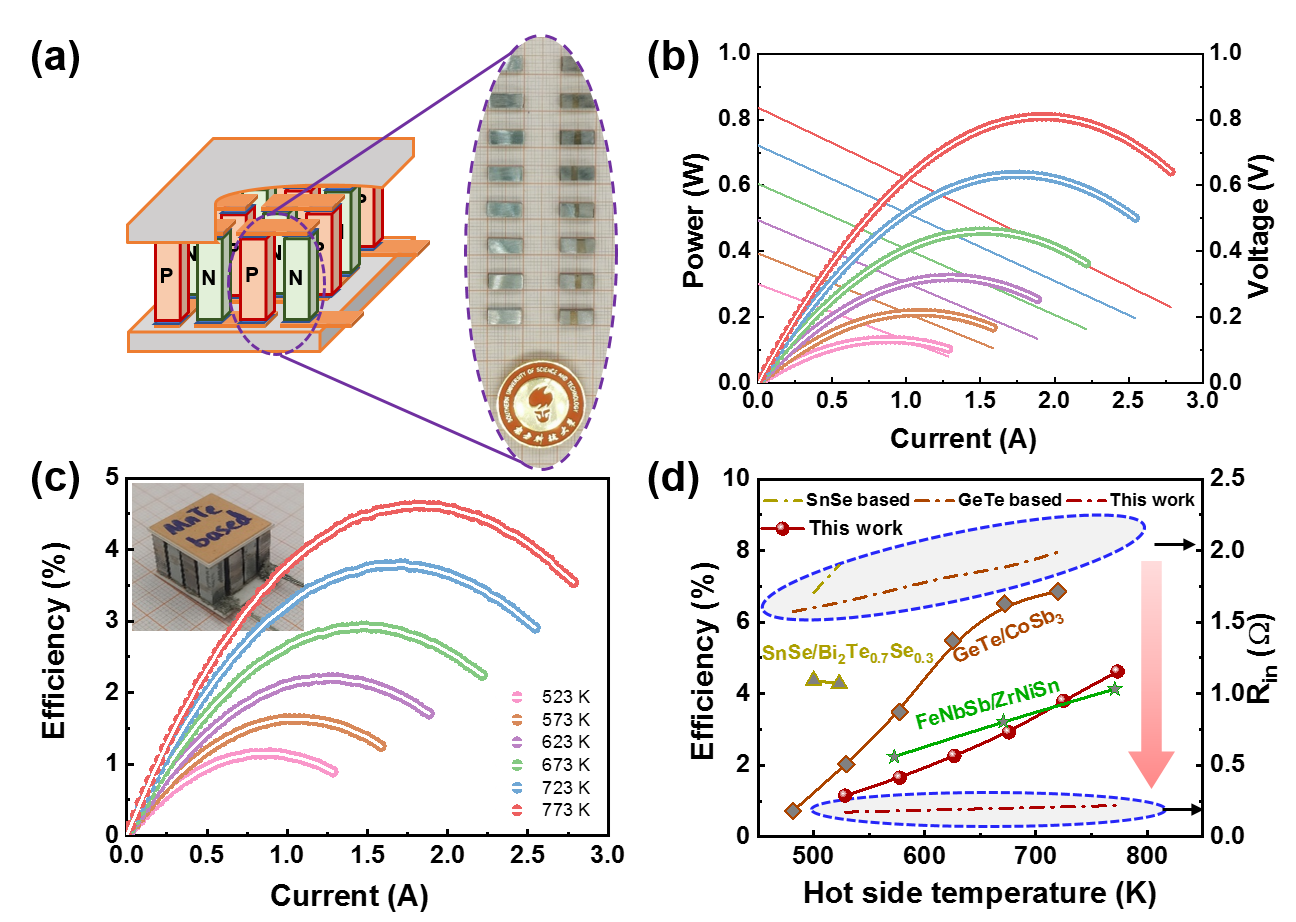Researchers optimize thermoelectric performance of MnTe-based materials
2023-08-08
Among the large family of thermoelectric materials, MnTe-based materials are expected to be a reliable alternative for the large-scale production of medium-temperature materials due to their low toxicity and abundant raw materials. However, the low carrier concentration and low mobility of carriers in MnTe-based thermoelectric materials have limited their applications.
Numerous research studies have focused on doping alkali metal elements to optimize the carrier concentration. However, the use of alkali metals inevitably suppresses the carrier mobility, resulting in difficulties in further improving the overall thermoelectric performance. Therefore, systematically addressing the contradictions among the relevant parameters is a challenging problem in the research of MnTe-based thermoelectric materials.

Yiyuan Luo and Jinghan Wang, undergraduate students of Chair Professor Jiaqing He’s research group from the Department of Physics at the Southern University of Science and Technology (SUSTech), recently collaborated to achieve the iterative reconstruction of the microstructure in MnTe samples to significantly optimize the electrical and thermal transport properties of the material. Moreover, they successfully assembled the first MnTe-based thermoelectric power generation module based on this material.
Their paper, entitled “Microstructural Iterative Reconstruction toward Excellent Thermoelectric Performance in MnTe”, has been published in the journal Energy & Environmental Science.
In this work, Yiyuan Luo and Jinghan Wang addressed the above problems through two rounds of structural reorganization. In the first round of optimization, the researchers synthesized polycrystalline MnSb2Te4 and reconstructed the microstructure of the sample at the unit cell scale. Hall measurements at room temperature showed that the carrier concentration of MnSb2Te4 polycrystals was over 100 times higher than that of MnTe samples, providing a new approach to optimizing the carrier concentration of MnTe.
As shown in Figure 1, transmission electron microscopy characterization results revealed that the prepared MnSb2Te4 polycrystals maintained the hexagonal crystal symmetry of the sample and introduced a layered structure with specific cation-anion layers into the original structure. First-principles calculations and experimental measurements demonstrated that the presence of this layered structure significantly reduced the lattice thermal conductivity of the material within the operating temperature range. Furthermore, the atomic-level spectroscopic analysis clearly showed that Mn, Sb, and Te atoms only occupied specific lattice sites, while the Mn raw materials used in the experiment did not fully enter the corresponding lattice, resulting in a large number of cation vacancy defects in the actual sample. This result provides a direct scientific basis for the high carrier concentration of MnSb2Te4 polycrystals.

Figure 1. (a) Schematic diagram of MnSb2Te4. (b) XRD patterns of polycrystals MnTe, Sb2Te3, and MnSb2Te4. (c) Low-resolution TEM and (d) the high-angle annular dark field (HAADF) STEM images of the MnSb2Te4 specimen, where the inset shows an enlarged view of the green area. (e) Profile of the white rectangle area in (d). (f) HAADF-STEM image of the selected area and (g-j) the atomic EDS images of the corresponding area.
In the second round of optimization, Yiyuan Luo and Jinghan Wang achieved point defect decoration by doping Mn sites in MnSb2Te4 with Ge, thereby reconstructing the microstructure of the sample at the atomic scale. On the one hand, experimental results showed a direct improvement in Hall mobility with increasing doping content. On the other hand, density functional theory (DFT) combined with Boltzmann transport theory analysis (Figure 2) demonstrated that after Ge doping, interlayer/intraband scattering in the MnSb2Te4 sample was significantly suppressed, leading to an optimization of relaxation time.
From a theoretical modeling perspective, this is greatly beneficial for improving the mobility of the sample. Additionally, band structure calculations revealed that the doped MnSb2Te4 configuration with Ge did not exhibit significant changes in the band structure and density of states. This implies that moderate Ge doping in MnSb2Te4 facilitates the single tuning of carrier concentration. This result highlights the advantage of microstructural modification through micro-doping, where the focus is on single parameter tuning compared to the multidimensional impacts caused by traditional doping methods.

Figure 2. (a) The calculated electronic band structure and projected density of states (PDOS) of MnSb2Te4. (b) The DOS results of MnSb2Te4 and 8.3% Ge-doped MnSb2Te4(top) and projected density of states (PDOS) of 8.3% Ge-doped MnSb2Te4(bottom). (c) The defect formation energy of Mn vacancies in non and 3.7% Ge-doped MnSb2Te4. Different Mn sites, charged and uncharged defect situations are considered, respectively. (d) The nH dependent σ based on the Boltzmann transport theory calculations.
After multiple iterations of microstructure reconstruction, this work achieved a peak ZT value of 1.3 (at 823 K) in the Mn0.96Ge0.04Sb2Te4 sample, with an average ZT of 0.71 between 323 K and 823 K, setting a new record for MnTe-based thermoelectric materials. Furthermore, this work also pioneered the fabrication of a MnSb2Te4-based single-stage thermoelectric power generation module.
The module consists of 8 pairs of p-n thermoelectric legs connected in series, as shown in Fig. 3, and it can achieve an electrical output power of 0.81 W (0.45 W cm-2) when the temperature at the high-temperature end reaches about 800 K. This result highlights the application potential of MnTe-based thermoelectric materials and devices.

Figure 3. (a) The schematic diagram of Mn0.96Ge0.04Sb2Te4-based modules. The current dependence of (b) voltage, power, and (c) efficiency under different hot temperature side, respectively. (d) Comparison of the measured efficiency and Rin values of the module and selected reported generating modules.
Yiyuan Luo and Jinghan Wang, along with Jianmin Yang, a joint Ph.D. student of SUSTech and the National University of Singapore (NUS), are the co-first authors of this paper. They contributed to sample preparation, thermoelectric performance measurement, and atomic-level structural characterization in this research, respectively. Chair Professor Jiaqing He and Dr. Xiao Xu, a Humboldt Fellow at Leibniz Institute for Solid State and Materials Research (formerly a postdoctoral fellow at SUSTech), are the corresponding co-authors. SUSTech is the first affiliation of the paper.
This work was supported by the Alexander von Humboldt Foundation, National Natural Science Foundation of China (NSFC), Science and Technology Innovation Committee Foundation of Shenzhen, and the Special Funds for the Cultivation of Guangdong College Students’ Scientific and Technological Innovation (Climbing Program Special Funds).
Yiyuan Luo and Jinghan Wang joined Professor Jiaqing He’s research group in 2020 and began their research on MnTe-based thermoelectric materials under the guidance of Dr. Xiao Xu. Regarding their learning experience and scientific achievements of this project, Yiyuan Luo expressed, “A rigorous process is more important than the results alone”.
Their research on MnTe-based thermoelectric materials spanned over three years, which was quite challenging for undergraduate students. In the initial stages of the experiments, they faced issues such as impurities in sample preparation, influenced by various objective conditions and human factors. After more than a year of learning and accumulation, they successfully suppressed the generation of most impurities. However, obtaining a single phase remained difficult.
With the guidance and assistance of Professor He, they eventually succeeded in synthesizing the polycrystalline compound MnSb2Te4. However, overcoming this hurdle was only the first step, as the outbreak of the pandemic added further complexity, but it also compelled them to develop good research habits. Jinghan Wang stated, “Professor He’s research group is not only a team with strict requirements for research details but also a loving family”.
Paper link: https://doi.org/10.1039/D3EE01902K
Prof. Jiaqing He’s group webpage: http://jqhphy.sustech.edu.cn




